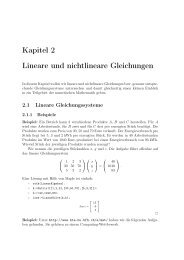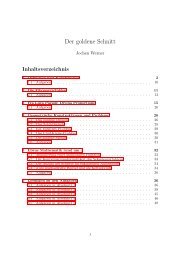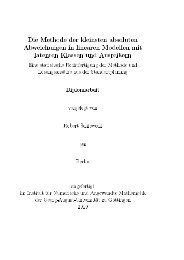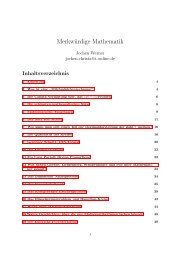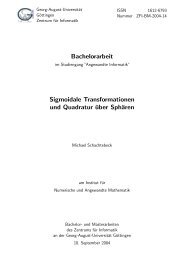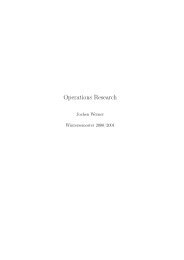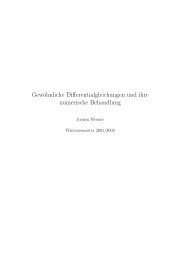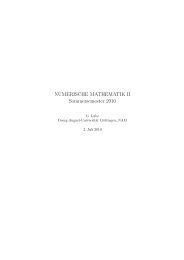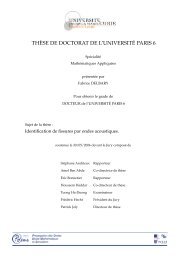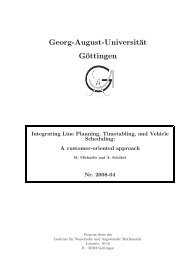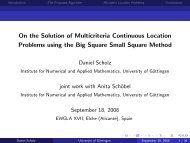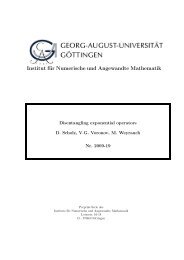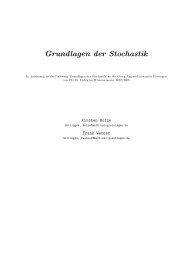BAIL 2006 Book of Abstracts - Institut für Numerische und ...
BAIL 2006 Book of Abstracts - Institut für Numerische und ...
BAIL 2006 Book of Abstracts - Institut für Numerische und ...
Create successful ePaper yourself
Turn your PDF publications into a flip-book with our unique Google optimized e-Paper software.
L. BOGUSLAWSKI: Sheare Stress Distribution on Sphere Surface at Different Inflow<br />
Turbulence<br />
✬<br />
✫<br />
<strong>BAIL</strong> <strong>2006</strong><br />
SHEARE STRESS DISTRIBUTION ON SPHERE SURFACE AT DIFFERNT INFLOW<br />
TURBULENCE<br />
L. Bogusławski<br />
Poznań University <strong>of</strong> Technology, Chair <strong>of</strong> Thermal Engineering, 60 965 Poznań, Poland;<br />
e-mail: leon.boguslawski@put.poznan.pl<br />
Momentum and heat transfer processes on surfaces are sensitive on intensity <strong>of</strong> turbulence <strong>of</strong> flow<br />
above surface. Descriptions <strong>of</strong> share stress or heat transfer distributions usually assume certain level <strong>of</strong><br />
intensity <strong>of</strong> turbulence <strong>of</strong> free flow which overflows surface. When structure <strong>of</strong> flow is formed as<br />
developed flow for typical channels one can assume that turbulence level and structure <strong>of</strong> turbulent<br />
flow is repeated. In such case detailed knowledge <strong>of</strong> flow turbulence is not necessary because<br />
Reynolds number indicated average flow similarity and similarity <strong>of</strong> turbulence by the way.<br />
Unfortunately for most technical applications level <strong>of</strong> turbulence and its structure can vary in wide<br />
borders. More over this level is difficult to prediction based on channel geometry especially when any<br />
promoters <strong>of</strong> turbulence occur. Experimental data indicate that increase <strong>of</strong> turbulence intensity cause<br />
increasing heat and momentum transfer coefficients even when average flow velocity does not change.<br />
To estimate influence <strong>of</strong> turbulence on local distribution <strong>of</strong> shear stress a sphere was chosen as the<br />
simplest, repeatable geometry. Flow was generated by a free ro<strong>und</strong> jet. Level <strong>of</strong> turbulence, in the jet<br />
axis, change from about 0.5% near the nozzle outlet till about 20% far away from the nozzle.<br />
Changing <strong>of</strong> the average flow velocity at the nozzle outlet it is possible to keep constant value <strong>of</strong><br />
velocity at different distances from the nozzle outlet. Turbulent fluctuations <strong>of</strong> a flow velocity were<br />
measured by means <strong>of</strong> a constant temperature anemometer. The local shear stress distribution on<br />
sphere surface was measured by used a surface sensor connected to the constant temperature<br />
anemometer as well.<br />
For low level <strong>of</strong> turbulence the shear stress distribution was similar to literature data. Increase <strong>of</strong><br />
turbulence cause increase <strong>of</strong> a local value <strong>of</strong> shear stress. The local share stress distributions and its<br />
turbulent fluctuations for two chosen turbulence level are presented in figure 1 as an example. The<br />
Reynolds number <strong>of</strong> average flow was the some for both cases. Increasing <strong>of</strong> inflow turbulence level<br />
cause increasing <strong>of</strong> local, average shear stress distributions and equalizing distribution <strong>of</strong> ‘rms’ <strong>of</strong><br />
turbulent fluctuations on rather high level.<br />
o<br />
3.0<br />
2.5<br />
2.0<br />
1.5<br />
1.0<br />
0.5<br />
d = 0.03 m, Re = 3 10 4 , Tu = 2.5 %<br />
0.0<br />
0.0<br />
0 30 60 90 120 150 180<br />
φ<br />
3.5<br />
3.0<br />
2.5<br />
2.0<br />
1.5<br />
1.0<br />
0.5<br />
' rms / ' orms<br />
0.0<br />
0.0<br />
0 30 60 90 120 150 180<br />
Figure 1. Distribution <strong>of</strong> the local average shear stress and its turbulent fluctuations on the sphere<br />
surface at different inflow turbulence level.<br />
o<br />
3.0<br />
2.5<br />
2.0<br />
1.5<br />
1.0<br />
0.5<br />
d = 0.03 m, Re = 3 10 4 , Tu = 12.3 %<br />
Speaker: BOGUSLAWSKI, L. 73 <strong>BAIL</strong> <strong>2006</strong><br />
φ<br />
3.5<br />
3.0<br />
2.5<br />
2.0<br />
1.5<br />
1.0<br />
0.5<br />
' ms / ' orms<br />
✩<br />
✪



